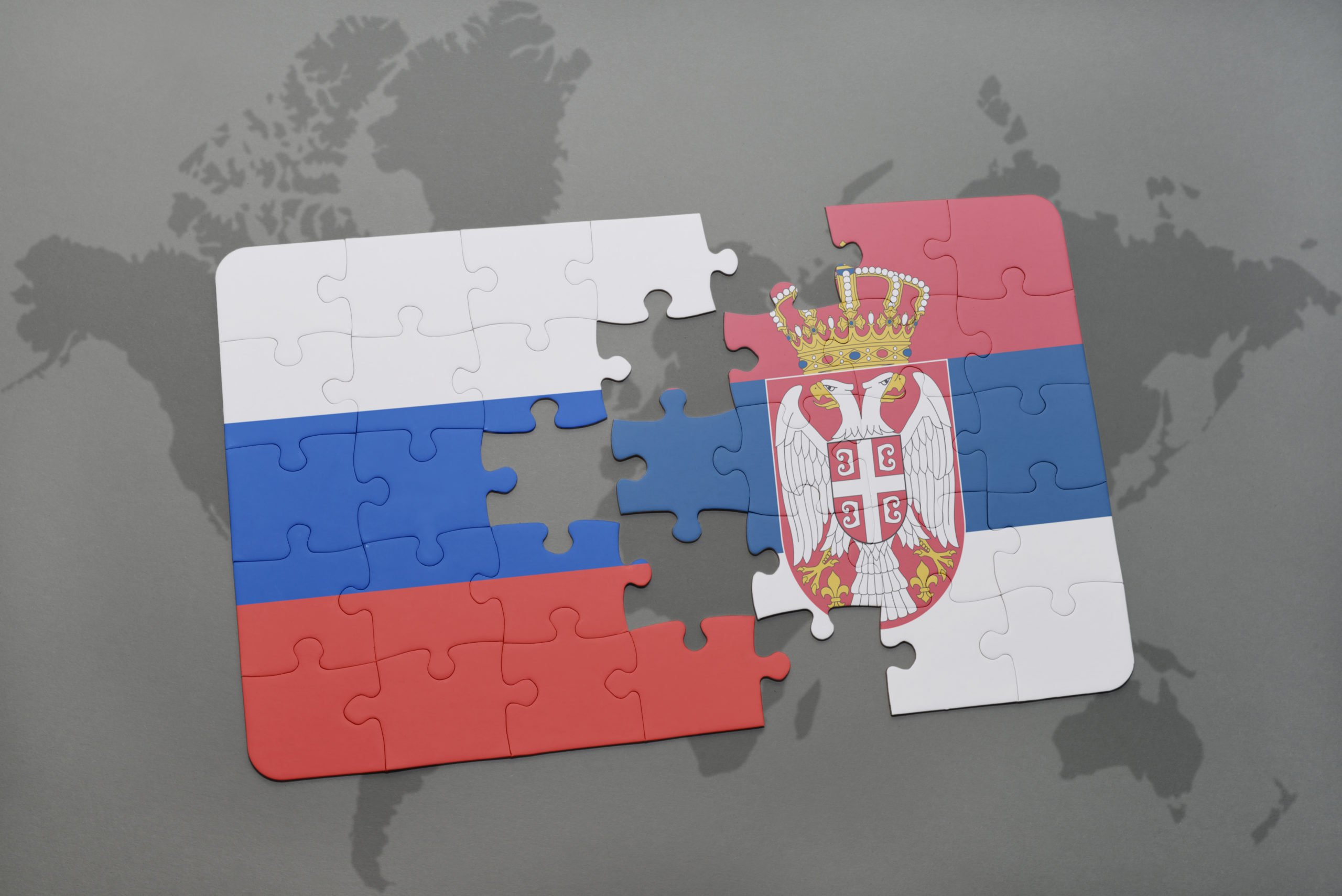Russian Propaganda & Disinformation Campaigns in Serbia’s Media
Sára Gregová
Russia is not a stranger to the use of propaganda and disinformation campaigns. One of the countries where Russian propaganda found fertile ground is Serbia. Propaganda and disinformation are used in a way to present the West negatively and Russia positively. It is mainly used to slow down Serbia’s Western integration efforts and to create an image of Russia as a supporter of Serbia.
Kremlin discovers soft power
Traditionally, Russia has been primarily focused on its military strength. However, in recent years, Kremlin’s security strategy underwent profound changes, and Russia is not a stranger to the use of propaganda and disinformation campaigns. Since the mid-2000s, Kremlin has attempted to develop its own soft power concept and implementation mechanism. In 2013, the idea of soft power was officially introduced in Russian foreign policy doctrine as the most important part of the Russian security strategy and foreign policy arsenal. This security strategy shift was born out of fear of a regime change in Russia and in the post-Soviet states. There are three main events that fed this fear and served as drivers for the rise of soft power in Russian strategy and its use in the international arena.
Kremlin first realized the importance of soft power after 2004, when post-Soviet Eurasia experienced a wave of anti-regime protest movements called „colored revolutions“. Colored revolutions were democratic protests with the main aim of overturning the pro-Russian regimes in Georgia, Ukraine and Kyrgyzstan. Another breaking point occurred in 2011/12 when Russian citizens themselves took to the streets to protest the parliamentary and presidential election results. In the Russian State Duma elections, electoral rigging took place to preserve the parliamentary majority of the governing party, United Russia. Another catalyst of the demonstrations was Putin’s decision to run for the third term, despite the fact that he had already served two terms as president. The regime interpreted the demonstrations as fuelled from the outside and as an interference in the Russian public sphere by the West. These events created a narrative of a wave of pro-democracy and pro-reform movements that had the potential to overthrow the current political regime in Russia. As a response, Russia started to invest massively in cyber strategy, propaganda and disinformation. In 2012, Putin defined soft power, as the use of information and cultural links, as a part of a bigger hard power strategy.
Another breaking point occurred when Ukraine moved closer to the EU’s institutions. In 2007, Ukraine started negotiations with European Union over the Association Agreement, which promoted stronger political and economic ties between them. However, in 2013, the newly elected pro-Russian president of Ukraine, Viktor Yanukovych, decided not to sign the Association Agreement. This decision sparked pro-European demonstrations, called “Euromaidan protests”, which resulted in the impeachment of Yanukovych. Russia perceived the impeachment as illegal and tried to portray that the new Ukrainian “post-maidan” government was formed by “extremists” who posed a “danger to Russians in Ukraine”. As a response, Putin annexed Crimea, and the West decided to impose sanctions on Russia and some of its companies. For the sake of protecting Russian national interests, Kremlin chose a more aggressive response: to expand rivalry to the EU’s backyard, to Western Balkans. Prior to 2014 Kremlin’s interests in the region were limited to economic expansion, such as investments in strategic sectors. After the annexation, Russia took a more assertive stance in the region.
Russian propaganda finds fertile ground in Serbia
Serbia is of great geostrategic importance for Moscow and a key pillar of its interests in the Western Balkans. In Serbia, the Kremlin exploits cultural connections and leverages its near monopoly on energy supplies to attempt to slow down Serbia’s Western integration efforts.
One of the many reasons why Russian propaganda and disinformation campaigns are successful is the emotional bond based on cultural connections. References to the common Orthodox Church and Slavic ethnicity represent the core of Russian strategy in Serbia. There is strong cooperation, at the highest level, between the Russian Orthodox Church and the Serbian one. Putin uses the Russian Orthodox church to extend and legitimize the interests of Russia. Historically, Russia is considered the protector of Serbia because it was able to defend Serbia on a number of occasions – or at least so does the common mythology say.
The attractiveness of Russian propaganda is multiplied by negative sentiments toward the West. These negative sentiments were born out of the NATO bombings of former Yugoslavia in 1999 during the Kosovo war. Moreover, the slow integration process of Western Balkan countries into the European Union also feeds negative sentiments. Europeanisation and EU membership has always been one of the priorities for all post-Milosevic governments – at least in words. However, the EU officials do not want to import political instability into the EU, meaning accepting countries with existing high-political issues. In the case of Serbia, we can consider high-political issues Belgrade-Pristina relations and border disagreement in Vojvodina. All of this contributes to “EU accession fatigue“ in Serbia.
Russia also exploits nationalistic sentiments and interethnic rivalry. The issue of Kosovo is one of the prime examples. Putin uses the case of Kosovo as a counterargument against Western “double standards”. Kosovo gained independence from Serbia in 2008, however, Serbia still does not recognize Kosovo as a separate country. Kremlin supports the Serbian stance by rejecting Kosovo’s independence also in the United Nations, where Russia is a permanent member of the Security Council. Russia is positioning itself as a guardian of Serbian interests vis- à-vis Kosovo and of Serbian minorities in neighboring countries.

Russia and Serbia. Photo: Esfera /Shutterstock
The main narratives of Russian propaganda and disinformation campaign
Pro-Russian media in Serbia promotes a few main narratives. Firstly, they promote the Russian viewpoint of international politics. The Russian viewpoint is characterized by claiming that West policy towards the Balkan region is not based on promoting democratic values but on geostrategic interests, such as eliminating Russian influence in the region. The reason behind this is that the West’s aim is to establish supremacy in global politics and economy since it feels threatened by alternative socio-political systems that are more effective. For example, the 2013/2014 revolution in Ukraine is viewed in pro-Russian Serbian media as a coup organized by the United States. In this regard, we can consider Russian propaganda as successful because, according to the Belgrade-based rights watchdog Crta, 3/4 of Serbians do believe that Russia was forced into the war with Ukraine because of NATO’s expansionist intentions.
The second narrative revolves around the effort to discredit the EU and NATO. Pro-Russian media claim that Euro-Atlantic institutions endanger Serbia’s independence and sovereignty. They spread false claims such as the EU has been supporting separatist groups in the region of Vojvodina or that EU accession would cause exploitation of Western Balkan markets by European businesses. As a result, the same poll conducted by Crta shows that 40% of Serbs would give up the country’s pursuit of joining the EU, and they would ally with Russia instead.
Pro-Russian media also put emphasis on common history and cultural links between Russia and Serbia, as mentioned above, but also on Russian investments that brought economic benefit to the country. They primarily focus on the energy sector and the company Gazprom, which is represented as the biggest taxpayer, key contributor to the state budget, and key employer. The emphasis is also put on Russian infrastructure loans and Russian-Serbian defense cooperation. However, the reality contrasts this narrative since the EU is the largest donor and investor in Serbia. „Foreign direct investments coming from the EU accounted for more than 63% of total FDI coming to Serbia from 2010 until 2021.“ (European Union, 2021) Russian-Serbian military cooperation is also insignificant when compared to NATO’s cooperation with the Serbian military sector. Cooperation between NATO and Serbia is developed in the scientific, political and military areas through initiatives and programs such as the Partnership Interoperability Initiative, NATO Trust Fund projects, and Building Integrity, just to mention a few.
Emphasis is also put on the glorification of Putin’s persona. Pro-Russian media in Serbia give Putin almost divine status and portray him as a supreme leader with almost superhuman traits. The main goal is to show that “Russia is Putin, and Putin is Russia”. Overall, the Russian propaganda and disinformation campaign is about showing Serbia that there is an alternative paradigm to the Western liberal system and that it is Putin’s system.
Russian channels of influence in the Serbian media sector
Mass media and propaganda are inseparable. The conjunction of propaganda and mass media enabled propaganda to reach a maximum of its effectivity. The success of Russian propaganda in media derives from the fact that critical media are often under the threat of violence, and most of the media is under government control, meaning the independent media are extremely underdeveloped. Thus, the majority attitude of the population is pro-Russian, to maintain a high rating among the voters, the Serbian government tolerates or even creates pro-Russian narratives. Moreover, the independent media sector suffers from chronic underfunding. Russian media provides free content or advertising, and they do not charge any fee for republishing their content and since the independent media sector is underfunded, the free information offered by Russia gains even more importance. Local media have made use of this possibility and decided to republish the content from Russian outlets.
Prior to 2012, Russian presence in the Serbian media sector was limited. In 2012, Russia-based company East Media Group became the owner of 50% of the shares of the German media house, which was, until then, the Publisher of Politika, one of the most influential newspapers in Serbia. The owner of the remaining 50% is PJP company, owned mostly by the Serbian state. Nowadays, Russia has a very strong influence on Serbian media. However, finding direct evidence of Russian funding is complicated since most of these outlets are not even registered in the Media Registry.
Russia gained the most influence in the Serbian media sector in 2015, with the arrival of the Russian state-funded news agency Sputnik when one of its offices was opened in Belgrade. Sputnik is a news agency, internet portal and radio station operated by the Russian state news agency called RT. The chief editor of Serbia-based Sputnik, Ljubinka Milinčić claimed that the world lacks a more truthful view of reality and that it is necessary to show that Western media are not always right. Sputnik often represents the reality in a way that creates resentment towards the US, EU or NATO with headlines such as: “New official NATO strategy: Aggressive intentions against Russia and China for the sake of globalist interests“ or “About the US preparations for a confrontation with Russia in Europe“. In the future, RT wants to expand its Russian propaganda and plans to start TV broadcasts by 2024, which will cover political events from an alternative point of view, according to the statement from RT.
Indeed, the biggest source of pro-Russian narratives comes from pro-government Serbian tabloids. The reason behind this is that pro-Russian Serbs account for a large share of voters of the ruling Serbian Progressive Party (SPS), President Aleksandar Vučić’s party. The most prominent and notorious are Informer, Srpski Telegraf, Ruska reč, or Pečat. In general, those newspapers glorify Russian presence in the region and promote economic and military cooperation between the two countries. The daily Blic is the only pro-government media that is not pro-Russian. One of the few independent media is Danas and Nova, owned by American United Media.
What makes Russian propaganda in the Serbian media sector even more dangerous is that it is transnational. Disinformation campaigns are often outward-looking and prominent throughout the region, particularly in Bosnia and Herzegovina (in Republika Srpska), Montenegro, Kosovo and North Macedonia.
Conclusion
It is crucial to realise that the solution to this problem lies in the independence of media that would check and balance the political elites. It is necessary to stop the hounding of independent journalists so they can refute the alternative view of political events promoted by Moscow. The most serious consequence is that propaganda spread by Moscow and the bias in the media sphere can negatively affect the ability of Serbian citizens to participate in the democratic process in a rational manner, which can lead to the creation of a dysfunctional political environment.
Sára Gregová is a student of the Faculty of Social Studies, Masaryk University in Brno, Czech Republic and an Intern of the Strategic Analysis‘ Young Leaders Programme.
Disclaimer: Views presented here are those of the author solely and do not necessarily reflect the views of the Strategic Analysis.


Contact us